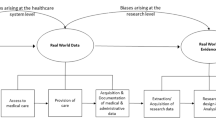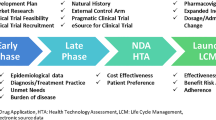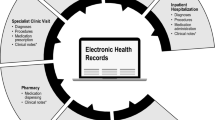Abstract
This paper discusses key challenges and opportunities that arise when using linked electronic health records (EHR) in health economics and outcomes research (HEOR), with a particular focus on estimating healthcare costs. These challenges and opportunities are framed in the context of a case study modelling the costs of stable coronary artery disease in England. The challenges and opportunities discussed fall broadly into the categories of (1) handling and organising data of this size and sensitivity; (2) extracting clinical endpoints from datasets that have not been designed and collected with such endpoints in mind; and (3) the principles and practice of costing resource use from routinely collected data. We find that there are a number of new challenges and opportunities that arise when working with EHR compared with more traditional sources of data for HEOR. These call for greater clinician involvement and intelligent use of sensitivity analysis.
Similar content being viewed by others
Notes
Rules for identifying events from the CALIBER data platform can be found on the CALIBER data portal: https://www.caliberresearch.org/portal.
The classification of resource use into HRGs in England can be automated using the grouper tool produced by the NHS HSCIC (Health and Social Care Information Centre) and made available online. A grouper is produced for each year of data which applies the rules as defined in that year to derive the HRGs relevant for that year. http://www.hscic.gov.uk/article/2062/Archive-costing.
References
Lewsey J, Leyland AH, Murray GD, Boddy FA. Using routine data to complement and enhance the results of randomised controlled trials. Health Technol Assess 2000;4(22):1–55.
Hemingway H, Croft P, Perel P, et al. Prognosis research strategy (PROGRESS) 1: a framework for researching clinical outcomes. BMJ. 2013;346:e5595. doi:10.1136/bmj.e5595.
Denaxas SC, George J, Herrett E, et al. Data resource profile: cardiovascular disease research using linked bespoke studies and electronic health records (CALIBER). Int J Epidemiol. 2012;41:1625–38. doi:10.1093/ije/dys188.
Rapsomaniki E, Timmis A, George J, et al. Blood pressure and incidence of twelve cardiovascular diseases: lifetime risks, healthy life-years lost, and age-specific associations in 1·25 million people. Lancet. 2014;383:1899–911. doi:10.1016/S0140-6736(14)60685-1.
Pujades-Rodriguez M, George J, Shah AD, et al. Heterogeneous associations between smoking and a wide range of initial presentations of cardiovascular disease in 1 937 360 people in England: lifetime risks and implications for risk prediction. Int J Epidemiol. 2014;129–41. doi:10.1093/ije/dyu218.
Rapsomaniki E, Shah A, Perel P, et al. Prognostic models for stable coronary artery disease based on electronic health record cohort of 102 023 patients. Eur Heart J. 2014;35:844–52. doi:10.1093/eurheartj/eht533.
Asaria M, Walker SM, Palmer SJ, et al. Using electronic health records to predict costs and outcomes in stable coronary artery disease. Br Med J. 2015 (in review).
Walker SM, Asaria M, Manca A, et al. Long term health care use and costs in patients with stable coronary artery disease: a population based cohort using linked electronic health records (CALIBER). Eur Heart J Qual Care Clin. 2015 (in review).
Agrawal D, Das S, El Abbadi A. Big data and cloud computing: current state and future opportunities. In: Proceedings of the 14th International Conference on Extending Database Technology. 2011;530–3. doi:10.1145/1951365.1951432.
Triggle N. Care.data: how did it go so wrong? BBC News. 2014. http://www.bbc.co.uk/news/health-26259101. Accessed 6 Oct 2015.
Morley KI, Wallace J, Denaxas SC, et al. Defining disease phenotypes using national linked electronic health records: a case study of atrial fibrillation. PLoS One. 2014;9:e110900. doi:10.1371/journal.pone.0110900.
Herrett E, Shah AD, Boggon R, et al. Completeness and diagnostic validity of recording acute myocardial infarction events in primary care, hospital care, disease registry, and national mortality records: cohort study. BMJ Br Med J. 2013;346:f2350. doi:10.1136/bmj.f2350.
Thorn JC, Coast J, Cohen D, et al. Resource-use measurement based on patient recall: issues and challenges for economic evaluation. Appl Health Econ Health Policy. 2013;11:155–61. doi:10.1007/s40258-013-0022-4.
Grašič K, Mason AR, Street A. Paying for the quantity and quality of hospital care: the foundations and evolution of payment policy in England. Health Econ Rev. 2015;5:15. doi:10.1186/s13561-015-0050-x.
Busse R, Geissler A, Aaviksoo A, et al. Diagnosis related groups in Europe: moving towards transparency, efficiency, and quality in hospitals? Maidenhead: Open University Press; 2011. doi:10.1136/bmj.f3197.
Espinoza MA, Manca A, Claxton K, et al. The value of heterogeneity for cost-effectiveness subgroup analysis: conceptual framework and application. Med Decis Mak. 2014;34:951–64. doi:10.1177/0272989X14538705.
Acknowledgments
Miqdad Asaria took overall responsibility for the paper and its structure and contributed the sections on handling sensitive data and extracting clinical endpoints. Katja Grasic was responsible for the section on costing practice and Simon Walker was responsible for the sections on costing principles and costing for economic models. All authors commented and contributed to all parts of the paper. The authors would also like to acknowledge Sam Brilleman from the University of Bristol and Tarita Murray-Thomas from CPRD for their help and advice regarding deriving costs from administrative datasets.
Author information
Authors and Affiliations
Corresponding author
Ethics declarations
No funding was received for this article. Miqdad Asaria, Katja Grasic and Simon Walker each declare that they have no conflicts of interest.
Rights and permissions
About this article
Cite this article
Asaria, M., Grasic, K. & Walker, S. Using Linked Electronic Health Records to Estimate Healthcare Costs: Key Challenges and Opportunities. PharmacoEconomics 34, 155–160 (2016). https://doi.org/10.1007/s40273-015-0358-8
Published:
Issue Date:
DOI: https://doi.org/10.1007/s40273-015-0358-8




